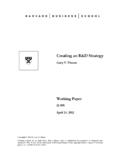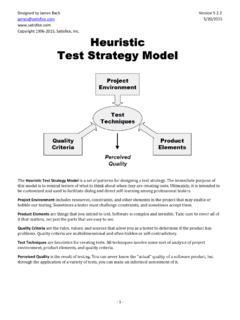Transcription of Lesson Plan Resources Teaching Strategy See attached ...
1 Lesson Plan Resources 2-Column Note Teaching Strategy See attached Graphic Organizer 3-2-1 Summarizing Strategy See below 3-Column Note Teaching Strategy See attached Graphic Organizer 5W & How Organizer Teaching Strategy See attached Graphic Organizer 5W Model Teaching Strategy See attached Graphic Organizer ABC Organizer Activating/Vocabulary See attached Graphic Organizer Acrostics Teaching Strategy Make up a sentence using the first letter of each word, sequencing, lists Example for order of operations in math: Please Excuse My Dear Aunt Sally Analyzing Perspective Teaching Strategy /Extended Thinking See attached Graphic Organizer Anticipation Guide Activating Strategy It is a list of statements (not questions) that are related to the reading selection.
2 The statements are not taken directly from the selection, but are inferential so that the students have to really read the selection and think about it. The students then decide whether they agree with each statement or disagree with it. One variation is that the students have to give proof from the selection to back up their opinions. Some of the statements should be written so that students can agree or disagree depending on how they interpret the information in the reading selection. This will encourage discussion.
3 (see example below) Assessment Prompts Formative assessment used to gather evidence of learning at strategic points throughout the Lesson , which helps the teacher adjust instruction to meet the needs of the learners. They can be in many formats: Written: Think-Ink-Share, Quick Write, Journal Response, Carousel brainstorm, RAFT, Math problems, Error Analysis Visual: Draw a diagram/sketch, Create a visual symbol, Complete a graphic organizer, Think-Sketch-Share Oral: Think-Pair-Share, Numbered Heads Together Show Me: Word sort, Classify items, Mini-whiteboard response, ABCD cards, Demonstrate Blog Summarizing Strategy A creative format that allows students to summarize learned material.
4 Brainstorm Graphic Organizer Activating or Teaching Strategy See attached Graphic Organizer Categorize Vocabulary Activating Strategy new topic students brainstorm ideas that they already know about the topic. You can use sticky notes or slips of paper for ideas from students. going over all their ideas, help them come up with categories on the board and have students put their ideas under the appropriate category (sticky notes under or tape the slips under the correct category.)
5 What they have accomplished on chart paper/whiteboard/Smart Board. As you work through the Lesson and learn new material, students can add more categories, ideas, and maybe revise previous information. Cause/Effect Teaching Strategy See attached Graphic Organizer Character Map Teaching Strategy See attached Graphic Organizer Chart/Diagram Activating Strategy new topic groups, pairs, or individually use blank paper/graphical outline/diagram/chart of topic draw, fill in outline/diagram/chart, or create diagram of the topic share their information this information so it can be revised or referred to during the Lesson Ex.
6 Diagram the inside of a cell, create a chart that represents the data set Classification Grouping items into definable categories on the basis of their attributes (Extended Thinking) See attached Graphic Organizer Compare/Contrast See attached Graphic Organizer (Extended Thinking) Concept Definition Map Activating/Vocabulary Strategy See attached Graphic Organizer Concept Map See attached Graphic Organizer Constructing Support See attached Graphic Organizer Creative Design Teaching Strategy Students create a model/representation of the learning throughout the learning experience.
7 With the model/representation complete, the student summarizes the process or learning. Cycle Graph See attached Graphic Organizer Deductive Reasoning See attached Graphic Organizer (Extended Thinking) Descriptive Organizer See attached Graphic Organizer Error Analysis See attached Graphic Organizer (Extended Thinking) Explanation Summarize learning Explanation/process Summarize learning based on the process or sequence Field Notes & Record Observe and record data based on observation and/or evaluation of material then summarize findings before progressing to the next level/step Fishbone Diagram Teaching Strategy Cause/Effect See attached Graphic Organizer Flow chart See attached Graphic Organizer FRAME See attached Graphic Organizer Frayer Activating/vocabulary Strategy See attached Vocabulary Graphic Organizer
8 Illustration Draw a picture that is a visual representation of the topic. This allows the student to conceptualize the topic and demonstrate understanding. Inductive Reasoning See attached Graphic Organizer (Extended Thinking) Interpretation Summarization Strategy This allows the student to write a journal or learning log entry based on his or her translation of the text, picture, musical piece, etc. Journal/Journal Entry Summarizing Strategy A written summary that reflects learning, misconceptions, and questions, and this journal can help the teacher know if she needs to review or move forward with the Lesson .
9 Justify Your Answer See attached Graphic Organizer K-W-L Activating Strategy This Strategy helps students make connections to what they know, what they want to learn, and new information they learn about a topic. It s a brainstorm tool to gather prior knowledge, preview new information and vocabulary, and recall information after learning it. See attached Graphic Organizer K-W-L Plus Activating Strategy This KWL has an added feature that allows the students to categorize their learning along with summarizing their learning.
10 See attached Graphic Organizer Label & Record Activating/ Teaching Strategy Students predict where target vocabulary is placed within a diagram or to label a model then explain their placement of each word. As the Lesson progresses the student makes revisions and explains the change. Or During the Lesson , each students labels the diagram/model recording their learning with specific details from the lecture, text, video, etc. Learning/Reflection Log Summarizing Strategy A written summary that reflects learning, misconceptions, and questions, and this journal can help the teacher know if she needs to re-teach or move forward with the Lesson .




